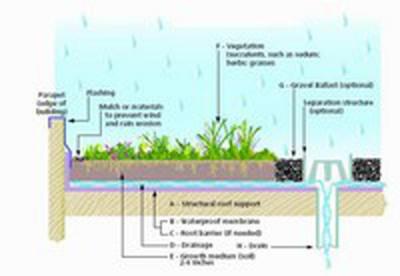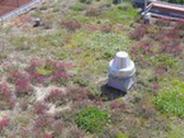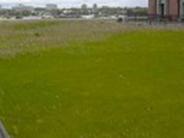Eco-Roofs
An eco-roof is a vegetated roof system that consists of lightweight soil and plants adapted to survive both the western Oregon wet winters and dry summers. Eco-roofs reduce or eliminate runoff from roofs, and filters pollutants. Additionally, eco-roofs provide habitat and food for insects and birds. Benefits to the building include increased insulation on the roof, mitigation building and roof temperatures, and potentially longer lifespan than traditional roofs.
Specifications
The most important criteria in designing an eco-roof is to ensure that the structure is strong enough to support the additional wet weight of the soil and plants (approximately 10 to 25 pounds per square foot). Calculations proving that that there is adequate support are required. In general, an existing building with a gravel-rock flat roof will support 10-12 pounds per square foot.
The second most important aspect of eco-roof design is the waterproofing material. There are numerous choices, with different strengths and characteristics. Check with the product manufacturer for more information. The waterproofing layer may not be impregnated with pesticides or any other material that will leach into the stormwater system. Some waterproof membrane systems require a root barrier to prevent damage to the membrane from deep penetrating roots. Additional protection boards or materials, often a soft, fibrous material, may be required.
Most large eco-roofs will require a drainage layer to prevent ponding on the surface and to channel water to an approved conveyance system.
Drainage layers can be perforated plastic sheets, thin layers or gravel, or if the roof is small or pitched, the growth medium may provide sufficient drainage. A drain must be provided that will safely drain excess runoff to an approved conveyance system.
In order to provide healthy growing conditions for the plants, the soil should be 2 to 6 inches thick of a light-weight mix of well-drained soil with organic matter and nutrients. One recommended mix is one quarter topsoil, one quarter compost, and one half pumice perlite. Vegetation to grow in this soil should be drought-tolerant, requiring little or no irrigation once established (2 years), be self-sustaining, not requiring fertilizers, pesticides, or herbicides, be very low maintenance, requiring little or no mowing, trimming, or replanting, and be able to withstand heat, cold, and high winds. Plants should be chosen that spread to thoroughly cover the soil. After 2 years, at least 90% of the surface must be covered with vegetation.
Planting Specifications
Recommended plants include sedums and other succulents, with the addition of herbs, forbs, grasses, and other low groundcovers. Vegetation must cover at least 90% of the surface area within 2 years of planting, and should require little or no irrigation or maintenance once established. Erosion control must be provided during establishment if bare soil is exposed. Four methods are typically used to install plantings for an eco-roof: vegetation mats, plugs or potted plants, sprigs, or seeds. Any are acceptable, provided that adequate plant quantities and coverage are provided.
Maintenance Requirements
- Provide irrigation (if necessary) for establishment of plants
- Reseed/replant as needed to ensure 90% cover of plants
- Spread mulch or other similar material to prevent loss of soil from wind erosion
- Maintain adequate flow through inlet and outlet pipes
- Weed and remove nuisance and prohibited plants when discovered
- Trash or debris shall be removed as soon as it is observed
- Any standing water 48 hours after a rain event shall be manually removed, and the source and cause of ponding shall be fixed
- Inspect for structural integrity and proper function and repair any deficiencies
Eco-Roof Locations in Sandy
None at this time
Resources Used
- City of Gresham Department of Environmental Services Stormwater Division. Water Quality Manual. Summer 2003.
- City of Oregon City. City of Oregon City Stormwater and Grading Design Standard; Chapter 5 of City Code.
- City of Portland Bureau of Environmental Services. Stormwater Management Manual. July 1, 1999; Revised 2004
- Clean Water Services. Design and Construction Standards for Sanitary Sewer and Surface Water Management. March 2004.
- Sound Native Plants. Environmental Conditions Favorable for Establishment of Outplanted/Transplanted Plants. 2000.
- Additional information and resources are available on the City of Portland Bureau of Environmental Services web page



